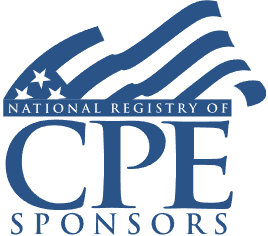Claiming the R&D Tax Credit: IRS Rules, Substantiation of QRAs and QREs, Offsetting Payroll Tax, AMT Liabilities

Course Details
- smart_display Format
On-Demand
- signal_cellular_alt Difficulty Level
Intermediate
- work Practice Area
Tax Law
- event Date
Thursday, September 16, 2021
- schedule Time
1:00 p.m. ET./10:00 a.m. PT
- timer Program Length
90 minutes
-
This 90-minute webinar is eligible in most states for 1.5 CLE credits.
-
BARBRI is a NASBA CPE sponsor and this 110-minute webinar is accredited for 2.0 CPE credits.
-
BARBRI is an IRS-approved continuing education provider offering certified courses for Enrolled Agents (EA) and Tax Return Preparers (RTRP).
This course will provide tax counsel and advisers a thorough and practical guide to Section 41 Research and Development (R&D) Income Tax Credits. The panel will identify activities treated as qualified research activities (QRAs), offer guidance on documenting and claiming the credit, outline strategies to allocate employee activities to QRAs, and other key items for using R&D Income Tax Credits and the IRS's approach to auditing R&D Income Tax Credits.
Faculty

Mr. Mitchell focuses on various state and federal tax matters and related business and probate matters, including tax procedural issues, questions about tax attributes, timing, character, and penalties and interest; structuring business and real estate transactions, including buying, selling, leasing, and other transfers and dispositions; tax planning for corporate and flow through entities; partnership tax issues, including partnership agreements and allocations; research tax credit issues, including qualification and funded research analysis. Previously, he worked for the IRS as an attorney and then an appeals officer. He’s led a tax controversy team for a boutique consulting firm, worked in the tax departments for two Fortune 500 companies, and worked for one of the Big Four accounting firms.
Description
For many businesses, the R&D tax credit is one of the most underutilized of all tax benefits. When claiming the R&D credit, determining what activities constitute qualified research activities (QRAs) and calculating qualified research expenses (QREs) can be challenging.
Section 41 allows a credit for a percentage of a QRE that a taxpayer incurs engaging in research activities. The Code provides a four-part test to determine whether an activity can be considered a QRA. Expenditures, including wage expenses with sufficient nexus to the QRA, can be included in calculating the expenditure base. However, substantiating that an activity qualifies as a QRA can still be complex, and tax professionals must know the standards and limits in utilizing this important and overlooked credit.
Listen as our experienced panel provides a thorough and practical review of calculating, claiming, and substantiating a Section 41 R&D credit.
Outline
- Overview of Section 41 R&D credit
- Determining QRAs
- Sampling and allocation methods
- Documentation and substantiation of credits
- Applying for credits against AMT or payroll tax liability
- IRS approach to auditing R&D tax credits
Benefits
The panel will discuss these and other important topics:
- The four-part test to determine whether an activity can be considered a QRA for purposes of claiming a Section 41 R&D credit
- Documentation and substantiation requirements
- Sampling strategies for including wage QREs and other indirect costs in the credit calculation
- Best practices for businesses claiming a Section 41 R&D credit
- Recent court cases and rulings
NASBA Details
Learning Objectives
After completing this course, you will be able to:
- Recognize the tests for determining whether an activity qualifies as a QRA for purposes of claiming a Section 41 R&D credit
- Identify wage QREs and other indirect expenditures under Section 41
- Discern strategies when eligible small companies may use IRC 41 credits to offset payroll tax or AMT liabilities
- Verify that all R&D tax benefits available are utilized for the client's benefit
- Field of Study: Taxes
- Level of Knowledge: Intermediate
- Advance Preparation: None
- Teaching Method: Seminar/Lecture
- Delivery Method: Group-Internet (via computer)
- Attendance Monitoring Method: Attendance is monitored electronically via a participant's PIN and through a series of attendance verification prompts displayed throughout the program
- Prerequisite: Three years+ business or public firm experience at mid-level within the organization, preparing business tax forms and schedules. Specific knowledge of business taxation, research and development tax credits, creditable expenses, qualified research activities, and documentation required to claim the IRC 41 tax credit; familiarity with allocation methods for qualified research expenditures, and AMT.

Strafford Publications, Inc. is registered with the National Association of State Boards of Accountancy (NASBA) as a sponsor of continuing professional education on the National Registry of CPE Sponsors. State boards of Accountancy have final authority on the acceptance of individual courses for CPE Credits. Complaints regarding registered sponsons may be submitted to NASBA through its website: www.nasbaregistry.org.

Strafford is an IRS-approved continuing education provider offering certified courses for Enrolled Agents (EA) and Tax Return Preparers (RTRP).
Related Courses

Taxation of U.S. Persons Owning Foreign Corporations: Strategies for Subpart F and GILTI Inclusions
Friday, April 11, 2025
1:00 p.m. ET./10:00 a.m. PT

U.S. Taxation of Foreign Individuals and Businesses: IRS Compliance and Enforcement
Tuesday, April 22, 2025
1:00 p.m. ET./10:00 a.m. PT

Equity Compensation Grants in Partnerships and LLCs: Overcoming Tax Challenges and Key Planning Techniques
Tuesday, April 22, 2025
1:00 p.m. ET./10:00 a.m. PT
Recommended Resources
How CPE Can Bridge the Gap Between What You Know and What You Need to Know
- Career Advancement
Gain a Competitive Edge Through Efficient CPE Strategies
- Learning & Development
- Business & Professional Skills
- Career Advancement